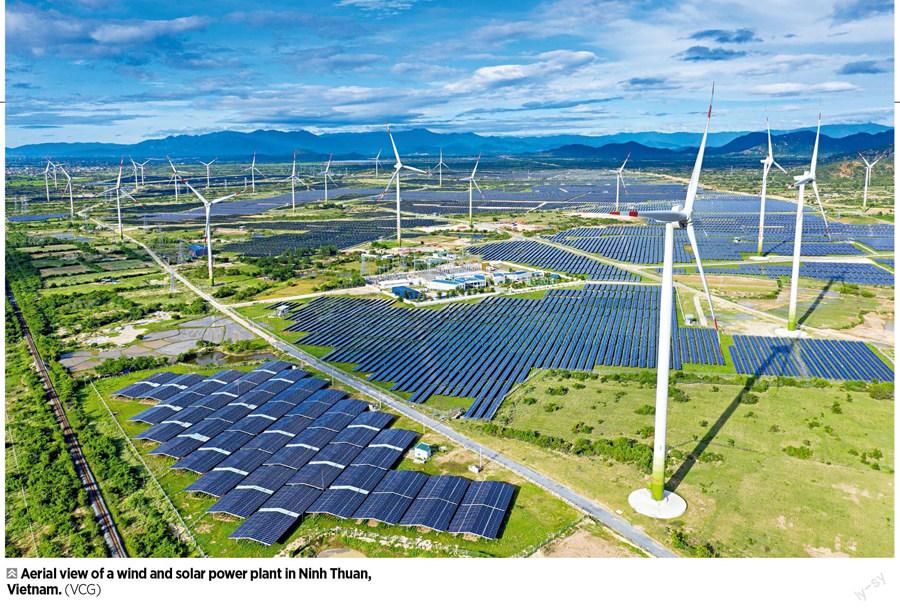Unlocking the Potential of China-ASEAN Wind Power Cooperation
2022-05-30GuoXixian
Guo Xixian



Wind power, especially low-wind-speed power, has tremendous development potential in ASEAN countries, which has inspired Chinese enterprises to act
ASEAN is among the regionsmost severely affected byclimate change. Its alsohighly dependent on fossilenergy. Developing renewable energy and promoting energy transformation is essentialfor ASEAN countries to cope withclimate change and achieve sustainable economic and social development.
At the 26th UN Climate ChangeConference (COP26) in November 2021, ASEAN countries released the ASEANPlan of Actionfor Energy Cooperation(APAEC)2021-2025, which set the target of a 23 percent share of renewableenergy in total primary energy supplyin the region and 35 percent in ASEANinstalled power capacity by 2025.
According to the ASEAN Centrefor Energy (ACE), natural gas and coalaccounted for about 69 percent of thenew installed power capacity in ASEAN in 2020, while its abundant renewableenergy sources have not yet beeneffectively developed, with less than 5 percent of the new installed capacitybeing powered by renewables and wind making up only 1.36 percent.
Zhou Shichun, deputy director ofinternational cooperation at the ChinaInstitute of Water Resources andHydropower Research (IWHR), said at the 2021 Beijing International WindEnergy Conference and Exhibition that the share of wind in power generationin China and the U.S. has increased to 5.4 and 6.9 percent respectively, whilethe share is only 1.2 percent in thePhilippines, and even below 1 percent in Thailand, Laos, and Vietnam. From the perspective of development potential and current scale, there is a huge space for ASEAN to develop wind power.
Many Chinese clean and low-carbon energy development enterprises have tried to seize opportunities to install wind power generation facilities in ASEAN countries. The Power Construction Corporation of China (PowerChina) is one of them. In an interview with China Report ASEAN, Li Sisheng, deputy chief engineer of PowerChina International Group and general manager of its new energy and power division, said that as one of the worlds largest power contractors, PowerChina will step up to the historic opportunity of energy and power transformation to strengthen international cooperation on green, clean and low-carbon development and provide Chinese solutions for a global low-carbon transformation and green development.
PowerChina has built many green power projects in Laos, Cambodia, Vietnam, and other ASEAN countries with a total capacity of more than 8,000 MW, laying a solid foundation for achieving carbon neutrality. In July 2021, PowerChina reached an agreement with Vietnams WTO Company on building the largest offshore wind power plant in Southeast Asia. Upon completion, the plant will add about 1.1 billion kilowatt-hours of electricity annually, meeting the average annual demand for electricity by 250,000 local residents, which will save about 450,000 tons of standard coal and reduce carbon dioxide emissions by about 880,000 tons. The new plant will significantly improve the power shortage situation in the area and southern Vietnam as a whole. PowerChina has become the largest new energy power contractor in Vietnam.
Although the COVID-19 pandemic created some challenges to power cooperation between China and ASEAN, development of power projects has maintained a fine growth momentum. Yang Kun, executive vice president of the China Electricity Council (CEC), said at the 2021 China-ASEAN Electric Power Cooperation and Development Forum that in 2020, Chinas major electric power enterprises invested in 15 projects in ASEAN countries, with a total investment of US$1.89 billion, for a growth rate of 24.7 percent. At present, power cooperation between China and ASEAN countries involves hydropower, wind power, and solar power projects, as well as power grid construction, which has effectively ensured local power supply and rapid and stable economic and social development.
Zhang Ruiqing, director of international cooperation at the China Electric Power Planning and Engineering Institute (EPPEI), noted at a seminar on potential and opportunity for an ASEAN green and lowcarbon transformation under the Belt and Road Initiative on March 24, 2022 that in the development of renewable energy, China has accumulated both experience and lessons. “Many parts of northern China are rich in the natural resources of wind and photovoltaic energy,” he said. “However, the resources were not utilized to the full. Now, with the advantage of a complete industrial chain, the resources have been fully utilized, and this can provide a valuable reference for ASEAN countries.”
Potential of Low-wind-speed Power
Due to the geographical environment of ASEAN countries, low-wind-speed energy resources within the range of average wind speed of 5-7m/s are the focus of development. In a report entitled “Research on Application of Low Wind Speed Power in ASEAN” jointly released by the IWHR and ACE, the total technically exploitable capacity of wind power in the 10 ASEAN member states was estimated at 1,112.3 GW. In 2019-2020, the new installed capacity of wind power in ASEAN countries was 4.4 GW, and total wind power generation reached 8,002 GWh, accounting for only 1 percent of power generation sources of ASEAN countries. About 13.5 percent of the land in ASEAN countries is in lowwind-speed areas, and low-wind-speed resources account for 75 percent of total exploitable resources.
Akbar DwiWahyono, an ACE technical official, commented on the great potential for low-wind-speed power generation in ASEAN in a speech at the 2021 Beijing International Wind Energy Conference and Exhibition. Countries with relatively good wind energy resources are mainly distributed in the central and southern Indochina Peninsula as well as some areas of the Malay Archipelago. “It is highly significant for ASEAN member states to fully recognize this development potential,” he said.
In an interview with China Report ASEAN, Dong Yinming, general manager of the Asia Center at Goldwind International Holdings, said that increasing awareness about energy conservation and emissions reductions from the government and society, coupled with the rising cost of fossil energy, has pushed many ASEAN countries to begin adjusting their energy mix. “On the whole, Southeast Asia has a relatively open policy environment and great potential for wind power development,” said Dong.
On development of low-wind-speed power, Dong recognizes that as frontrunners in wind power generation, the United States and European countries have more mature technology. Progress in wind power technology, changes in electricity pricing policy, and saturation of market development in high-windspeed areas have shifted the center of gravity of wind power development to medium- and low-wind-speed areas. In areas with relatively scarce wind resources, Chinese wind power enterprises have led the introduction of low-wind-speed technology. They have accumulated rich experience and developed strong international competitiveness
Since it entered the ASEAN market in 2012, Goldwind has successively realized delivery and operation of lowwind-speed turbines in Thailand, Vietnam, and other countries. Goldwind is operating four wind power projects in Thailand with a total capacity of 107.5 MW. Increasing tower heights can expand the utilization of wind energy in vertical space, increase power generation and improve the economic benefits. In 2012, Goldwind led development of the technology to build a 120m+ highstrength steel tower for wind turbines and successfully applied it to Thailandprojects located in the low-wind-speed and high-shear areas. The first grid-connected project has already beenin stable operation for 10 years, andthe average annual availability of thewind farm has been more than 99percent. Goldwind is now operating or implementing 11 projects in Vietnam.
After more than 10 years of lowwind-speed product development and upgrading, Chinese enterprises have established a new energy industry covering the entire whole industrial chain. With their unique industrial advantages, they are helping other developing countries improve their abilities to cope with climate change with Chinese products and technology. They are also providing training for local wind power professionals and technical personnel.
Exploring the ASEAN Market
Dong Yinming said that because green development has become a global consensus, energy transformation is the only way forward. China has announced that it will stop overseas investment in coal power, sending a signal to relevant enterprises to invest in new energy projects overseas. All of ASEAN has an urgent need for new energy, especially new wind power projects. Although ASEAN countries have committed to carbon neutrality at COP26, it will take time for it to actually happen.
To help ASEAN countries accelerate green transformation, China proposed green energy be made a priority of Belt and Road cooperation. On March 28, 2022, four Chinese government ministries published Guideline on Joint Implementation of Green Development in the Belt and Road Initiative, which suggested that China promote international cooperation in green energy. The authorities will encourage solar, wind, and other renewable energy companies to “go global,” deepen cooperation in energy technology and equipment, and carry out joint research and exchange with focus on efficient and low-cost renewable energy power generation and smart grids.
Although Chinese enterprises are actively carrying out the industrialdistribution of wind power in ASEAN,many objective challenges remain.For example, some ASEAN countrieshave a weak industrial base, poor roadsand power grids, little constructionequipment, and an outdated local supply chain system.
The continued surge of COVID-19 and the ongoing Russia-Ukraine conflict have resulted in transportation bottlenecks and rising cost of raw materials, which will have a significant impact on delivery of the wind power projects now under construction and the cost of long-term operation.
Furthermore, ASEAN countries are at different stages of wind power development and have different support policies. For example, Vietnam was expected to release its eighth power development plan last year. However, due to the rising cost of coal power and Chinas decision to stop overseas investment in coal power, the Vietnamese government had to reassess relevant policies, bringing some uncertainty to the industry.
Du Haiyang, general manager of the PowerChina Vietnam Limited Company, highlighted the broad prospects for China-ASEAN wind power cooperation. He suggested the two sides enhance strategic mutual trust, synergize policies and development plans, actively promote practical cooperation in electric power generation, and exchange and share experience and practice in promoting green and lowcarbon electric power development, institutional reform, cross-regional power transmission, and trade.
At the 2021 China-ASEAN Electric Power Cooperation and Development Forum on September 10, 2021, CEC executive vice president Yang Kun proposed increasing investment in green and low-carbon power projects, promoting ecological friendliness in local power industries, designing a new cooperation model of “green financing” empowering “green power,” and jointly discovering new highlights of green Belt and Road cooperation in the ASEAN region.
